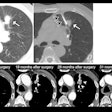The treatment of ostial stenoses can benefit from stent-assisted percutaneous transluminal renal angioplasty (PTRA), but stand-alone balloon PTRA works just fine for non-ostial renal arterial stenoses, according to Swiss researchers.
Dr. Iris Baumgartner and her co-authors from the University Hospital in Bern compared stent placement in ostial and nonostial atherosclerotic renal artery stenosis. The results of the prospective follow-up study appear in the August 2000 issue of Radiology.
"Because ostial lesions represent bulky plaques along the aortic wall that encroach the origin of the renal artery, the mechanisms of balloon PTRA, such as stretching and cracking of the interna and media and remodeling of the plaque, are impeded. Stent placement provides a luminal scaffolding that virtually eliminates recoil, a factor of paramount importance in ostial lesions," the authors wrote. (Radiology, Aug. 2000, Vol.216:2, pp.498-505).
The study population consisted of 163 patients with 200 atherosclerotic renal arterial lesions. They were treated with primary PTRA or primary stent insertion, the latter completed with pressure gradient lower than 10 mm Hg. At least 60% stenosis based on angiography was required for enrollment.
Ostial lesions were defined as stenoses located within 5 mm of the aortic lumen. Nonostial lesions met two criteria: proximal renal arterial stenoses located within 5 to 10 mm of the aortic lumen and isolated truncal renal arterial stenoses located more than 10 mm distally, as well as clearly separated from the aortic lumen.
"A standard retrograde femoral or brachial puncture was performed … and a diagonal catheter was advanced to just in front of the ostium of the stenotic renal artery to obtain a multiplane view," the authors wrote. Transstenotic pressure measurements were used to determine the success of the balloon dilation. Stent insertion was performed when one or both of the following conditions were present even after PTRA: a transstenotic pressure gradient higher than 10 mm Hg or an angiographic residual stenosis of more than 60% in diameter.
Follow-up exams were performed with duplex ultrasound using a 2.5-4.5 MHz phased-array transducer from Acuson of Mountain View, CA.
According to the results, the primary 12-month patency rates in 123 renal arteries treated with balloon PTRA were 34% for ostial stenoses, 65% for proximal stenoses, and 83% for isolated truncal stenoses. The patency rates achieved with stent-assisted PTRA in 64 renal arteries were 80% for ostial stenoses, 72% for proximal stenoses, and 66% for truncal stenoses.
The rate of complications directly related to balloon PTRA was 3.1%, while the complication rate for stent-assisted PTRA was 8.6%. There were three deaths, although none were related to the interventional procedure, the group reported.
"We observed a significantly improved 12-month patency rate in ostial stenosis treated with stent placements … our findings underline the necessity of stent placement for treatment of ostial stenosis and are evidence of the effectiveness of stand-alone balloon PTRA for treatment of nonostial renal arterial stenosis," they concluded.
By Shalmali PalAuntMinnie.com staff writer
August 18, 2000
Let AuntMinnie.com know what you think about this story.
Copyright © 2000 AuntMinnie.com

















